Top Ten Journal Articles of 2021
January 28th, 2022 | news
JSI staff continue to share their learning across a wide array of platforms, including through peer-reviewed journals. Read the articles on a range of topics, from supply chain to human-centered design, from immunization to HIV prevention.
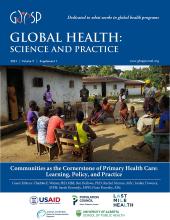 1. Using Human-Centered Design to Adapt Supply Chains and Digital Solutions for Community Health Volunteers in Nomadic Communities of Northern Kenya in Global Health Science and Practice
1. Using Human-Centered Design to Adapt Supply Chains and Digital Solutions for Community Health Volunteers in Nomadic Communities of Northern Kenya in Global Health Science and PracticeThis article highlights the use of human-centered design (HCD) to engage communities and community health volunteers (CHVs) in Kenya in redesigning a proven data-centric supply chain approach that includes the digital solution, cStock.
Authors: Sarah Andersson, Sarah Hassanen, Amos Momanyi, Danielson Onyango, Daniel Gatwechi, Mercy Lutukai, Karen Aura, Alex Mungai, and Yasmin Chandani
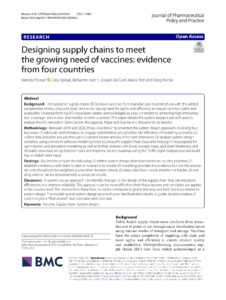 2. Designing Supply Chains to Meet the Growing Need of Vaccines: Evidence from four countries in Journal of Pharmaceutical Policy and Practice
2. Designing Supply Chains to Meet the Growing Need of Vaccines: Evidence from four countries in Journal of Pharmaceutical Policy and PracticeThis article details the system design approach used to analyze the immunization supply chain network in Sierra Leone, Madagascar, Niger, and Guinea and documents six key lessons that can be used to guide future interventions and improve supply chain performance.
Authors: Wendy Prosser, Cary Spisak, Benjamin Hatch, Joseph McCord, Marie Tien, and Greg Roche
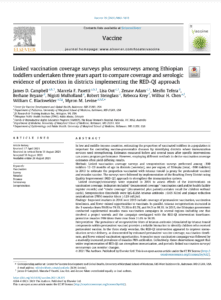 3. Linked vaccination coverage surveys plus serosurveys among Ethiopian toddlers undertaken three years apart to compare coverage and serologic evidence of protection in districts implementing the RED-QI approach in Vaccine
3. Linked vaccination coverage surveys plus serosurveys among Ethiopian toddlers undertaken three years apart to compare coverage and serologic evidence of protection in districts implementing the RED-QI approach in VaccineThis article details observations that wider implementation of the reaching every district-quality improvement (RED-QI) approach can strengthen immunization, and periodic linked vaccination surveys/serosurveys can monitor changes.
Authors: James Campbell, Marcela Pasetti, Lisa Oot, Zenaw Adam, Mesfin Tefera, Berhane Beyane, Nigisti Mulholland, Robert Steinglass, Rebecca Krey, Wilbur Chen, William Blackwelder, Myron Levine
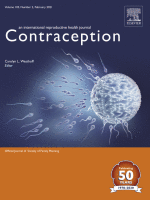 4. Increasing access to single-visit contraception in urban health care settings: Findings from a multi-site learning collaborative in Contraception Journal
4. Increasing access to single-visit contraception in urban health care settings: Findings from a multi-site learning collaborative in Contraception JournalThis paper identifies key facilitators and factors that influenced the successful implementation of recommendations for access to the full range of contraceptive methods in primary care, postabortion, and immediate postpartum settings in the United States. Findings can inform future initiatives that seek to increase contraceptive access at service delivery points, as a component of reproductive autonomy and contraceptive equity.
Authors: Jennifer Kawatu, Michele Clark, Katie Saul, Katie Quimby, Alzen Whitten, Sharifa Nelson, Kimberly Potter, Deborah Kaplan
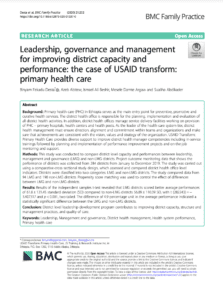 5. Leadership, governance and management for improving district capacity and performance: the case of USAID Transform: Primary Health Care in BMC Family Practice
5. Leadership, governance and management for improving district capacity and performance: the case of USAID Transform: Primary Health Care in BMC Family PracticeThis Ethiopia study compares district-level capacity and performances between leadership, management, and governance (LMG) and non-LMG districts.
Authors: Binyam Fekadu Desta, Azeb Abitew, Ismael Ali Beshir, Mesele Damte Argaw and Sualiha Abdlkader
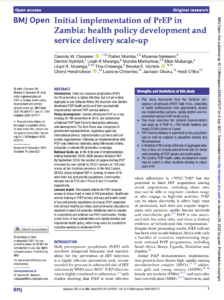 6. Initial implementation of PrEP in Zambia: health policy development and service delivery scale-up in BMJ Open
6. Initial implementation of PrEP in Zambia: health policy development and service delivery scale-up in BMJ OpenOur Zambia team found that risk-based criteria for PrEP ensure access to those most in need of HIV prevention. Healthcare worker training in PrEP service delivery and health needs of key and priority populations is crucial. PrEP expansion into primary healthcare clinics and community education is required to reach full potential.
Authors: Cassidy Claassen, Daliso Mumba, Mwansa Njelesani, Derrick Nyimbili, Linah Mwango, Mundia Mwitumwa, Ellen Mubanga, Lloyd Mulenga, Tina Chisenga, Brooke Nichols
 7. Country perspectives on improving technical assistance in the health sector in Gates Open Research
7. Country perspectives on improving technical assistance in the health sector in Gates Open ResearchThis paper presents learnings from the Re-Imagining Technical Assistance for Maternal, Neonatal, and Child Health and Health Systems Strengthening (RTA) project implemented in the Democratic Republic of the Congo and Nigeria from April 2018 to September 2020 by JSI Research & Training Institute, Inc. and Sonder Collective
Authors: Natasha Kanagat, Jeanne Chauffour, Jean-Fidèle Ilunga, Sylvain Yuma Ramazani, John J.P. Ovuoraye Ajiwohwodoma, Salma Ibrahim Anas-Kolo, Oleka Maryjane, Nkeiru Onuekwusi, Toto Ezombe, James Dominion, Joseph Sunday, Joseph Kasongo, Gavial Ngambwa, Christy Asala, Célestin Nsibu, Abimbola Williams, Melanie Wendland, Emilia Klimiuk, Anne LaFond, Nosa Orobaton, Dyness Kasungami
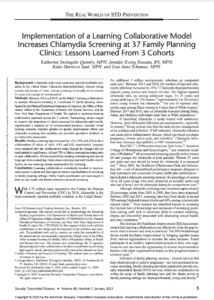 8. Implementation of a Learning Collaborative Model Increases Chlamydia Screening at 37 Family Planning Clinics: Lessons Learned From 3 Cohorts in Sexually Transmitted Diseases
8. Implementation of a Learning Collaborative Model Increases Chlamydia Screening at 37 Family Planning Clinics: Lessons Learned From 3 Cohorts in Sexually Transmitted DiseasesLearning collaboratives funded by the Planned Parenthood Federation of America, the Office of Population Affairs in the Department of Health and Human Services, and the New York State Department of Health consistently resulted in improvement across 3 cohorts and shed light on barriers and facilitators to screening in family planning settings. Public health practitioners are encouraged to draw on our results and lessons learned to promote screening.
Authors: Katherine Quimby, Jennifer Kawatu, Katie Saul, Lisa Schamus
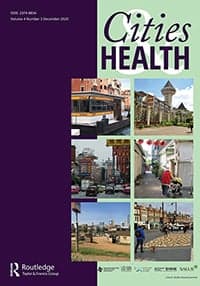 9. Exploring urban health inequities: The example of non-communicable disease prevention in Indore, India in Cities & Health
9. Exploring urban health inequities: The example of non-communicable disease prevention in Indore, India in Cities & HealthWe found that in Indore, behavioral risk factors such as tobacco, alcohol, and salt intake were more likely to be borne by those with low education and income, slum status, and temporary housing type, while diseases such as hypertension were borne more equally over the population. This analysis has shown techniques that urban health researchers and planners can use to understand the differentials of noncommunicable disease risk and where action can be taken to reduce inequities.
Authors: Amanda Pomeroy-Stevens, Damodar Bachani, Meera Sreedhara, John Boos, Ritvik Amarchand, and Anand Krishnan
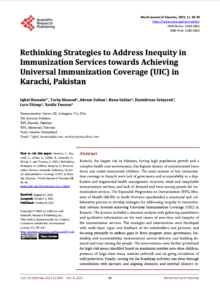 10. Rethinking Strategies to Address Inequity in Immunization Services towards Achieving Universal Immunization Coverage (UIC) in Karachi, Pakistan in World Journal of Vaccines
10. Rethinking Strategies to Address Inequity in Immunization Services towards Achieving Universal Immunization Coverage (UIC) in Karachi, Pakistan in World Journal of VaccinesThis paper highlights the unique process the Sindh Government, in collaboration with partners, undertook to develop strategies for addressing inequity in urban immunization services in Karachi in order to work toward achieving Universal Immunization Coverage.
Authors: Iqbal Hossain, Tariq Masood, Akram Sultan, Rana Sardar, Hamidreza Setayesh, Lora Shimp, Soofia Yonus
We strive to build lasting relationships to produce better health outcomes for all.